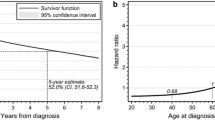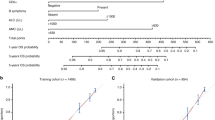Abstract
Prognostic markers identify subgroups of patients with similar risk profiles, helping to guide clinical care. The addition of rituximab to conventional anthracycline-based chemotherapy has improved clinical outcomes for patients with diffuse large B-cell lymphoma (DLBCL). Studies suggest that rituximab eliminates or modulates the significance of some markers (eg, BCL6 or BCL2), whereas other previously unimportant markers may emerge as significant prognostic indicators in the setting of treatment that now includes rituximab. These changes in the prognostic profile are likely to reflect the impact of rituximab on survival pathways important to some groups of patients with DLBCL but not to other groups, and thereby may provide clues to the underlying biology of the disease. They also identify subgroups of patients likely to benefit most from rituximab therapy and those who seem to garner no advantage from its inclusion in their treatment. Studies of prognostic indicators in the context of modern therapy have the potential to identify new, rational therapeutic targets for this biologically diverse disease.
Similar content being viewed by others
References and Recommended Reading
Swan F Jr, Velasquez WS, Tucker S, et al.: A new serologic staging system for large-cell lymphomas based on initial β2-microglobulin and lactate dehydrogenase levels. J Clin Oncol 1989, 7:1518–1527.
A predictive model for aggressive non-Hodgkin’s lymphoma—International Non-Hodgkin’s Lymphoma Prognostic Factors Project. N Engl J Med 1993, 329:987–994.
Fisher RI, Gaynor ER, Dahlberg S, et al.: Comparison of a standard regimen (CHOP) with three intensive chemotherapy regimens for advanced non-Hodgkin’s lymphoma. N Engl J Med 1993, 328:1002–1006.
Coiffier B, Lepage E, Briere J, et al.: CHOP chemotherapy plus rituximab compared with CHOP alone in elderly patients with diffuse large-B-cell lymphoma. N Engl J Med 2002, 346:235–242.
Feugier P, Van Hoof A, Sebban C, et al.: Long-term results of the R-CHOP study in the treatment of elderly patients with diffuse large B-cell lymphoma: a study by the Groupe d’Etude des Lymphomes de l’Adulte. J Clin Oncol 2005, 23:4117–4126.
Habermann TM, Weller EA, Morrison VA, et al.: Rituximab-CHOP versus CHOP alone or with maintenance rituximab in older patients with diffuse large B-cell lymphoma. J Clin Oncol 2006, 24:3121–3127.
Pfreundschuh M, Trumper L, Osterborg A, et al.: CHOP-like chemotherapy plus rituximab versus CHOP-like chemotherapy alone in young patients with good-prognosis diffuse large-B-cell lymphoma: a randomised controlled trial by the MabThera International Trial (MInT) Group. Lancet Oncol 2006, 7:379–391.
Pfreundschuh M, Kloess M, Schmits R, et al.: Six, not eight cycles of bi-weekly CHOP with rituximab (R-CHOP-14) is the preferred treatment for elderly patients with diffuse large B-cell lymphoma (DLBCL): results of the RICOVER-60 trial of the German High-Grade Non-Hodgkin Lymphoma Study Group (DSHNHL) [abstract]. Blood (ASH Annual Meeting Abstracts) 2005, 106:Abstract 13.
Coiffier B, Feugier P, Mounier P, et al.: Long-term results of the GELA study comparing R-CHOP and CHOP chemotherapy in older patients with diffuse, large B-cell lymphoma show good survival in poor risk patients. J Clin Oncol 2007, 25:18s.
Winter JN, Weller EA, Horning SJ, et al.: Prognostic significance of Bcl-6 protein expression in DLBCL treated with CHOP or R-CHOP: a prospective correlative study. Blood 2006, 107:4207–4213.
Sehn LH, Berry B, Chhanabhai M, et al.: The revised International Prognostic Index (R-IPI) is a better predictor of outcome than the standard IPI for patients with diffuse large B-cell lymphoma treated with R-CHOP. Blood 2007, 109:1857–1861.
Advani RH, Chen H, Habermann TM, et al.: Prognostic indices in older DLBCL patients receiving R-CHOP: an analysis of the U.S. Intergroup Study (E4494, CALGB 9793). Blood 2006, 108:244a.
Lossos IS, Morgensztern D: Prognostic biomarkers in diffuse large B-cell lymphoma. J Clin Oncol 2006, 24:995–1007.
Lossos IS, Jones CD, Warnke R, et al.: Expression of a single gene, BCL-6, strongly predicts survival in patients with diffuse large B-cell lymphoma. Blood 2001, 98:945–951.
Barrans SL, Carter I, Owen RG, et al.: Germinal center phenotype and bcl-2 expression combined with the International Prognostic Index improves patient risk stratification in diffuse large B-cell lymphoma. Blood 2002, 99:1136–1143.
Hans CP, Weisenburger DD, Greiner TC, et al.: Confirmation of the molecular classification of diffuse large B-cell lymphoma by immunohistochemistry using a tissue microarray. Blood 2004, 103:275–282.
Lossos IS, Czerwinski DK, Alizadeh AA, et al.: Prediction of survival in diffuse large-B-cell lymphoma based on the expression of six genes. N Engl J Med 2004, 350:1828–1837.
Savage KJ, Monti S, Kutok JL, et al.: The molecular signature of mediastinal large B-cell lymphoma differs from that of other diffuse large B-cell lymphomas and shares features with classical Hodgkin lymphoma. Blood 2003, 102:3871–3879.
Rosenwald A, Wright G, Leroy K, et al.: Molecular diagnosis of primary mediastinal B cell lymphoma identifies a clinically favorable subgroup of diffuse large B cell lymphoma related to Hodgkin lymphoma. J Exp Med 2003, 198:851–862.
Alizadeh AA, Eisen MB, Davis RE, et al.: Distinct types of diffuse large B-cell lymphoma identified by gene expression profiling. Nature 2000, 403:503–511.
Rosenwald A, Wright G, Chan WC, et al.: The use of molecular profiling to predict survival after chemotherapy for diffuse large B-cell lymphoma. N Engl J Med 2002, 346:1937–1947.
Nyman H, Adde M, Karjalainen-Lindsberg ML, et al.: Prognostic impact of immunohistochemically defined germinal center phenotype in diffuse large B-cell lymphoma patients treated with immunochemotherapy. Blood 2007, 109:4930–4935.
Cartron G, Watier H, Golay J, Solal-Celigny P: From the bench to the bedside: ways to improve rituximab efficacy. Blood 2004, 104:2635–2642.
Jazirehi AR, Huerta-Yepez S, Cheng G, Bonavida B: Rituximab (chimeric anti-CD20 monoclonal antibody) inhibits the constitutive nuclear factor-κB signaling pathway in non-Hodgkin’s lymphoma B-cell lines: role in sensitization to chemotherapeutic drug-induced apoptosis. Cancer Res 2005, 65:264–276.
Jazirehi AR, Vega MI, Chatterjee D, et al.: Inhibition of the Raf-MEK1/2-ERK1/2 signaling pathway, Bcl-xL down-regulation, and chemosensitization of non-Hodgkin’s lymphoma B cells by rituximab. Cancer Res 2004, 64:7117–7126.
Monti S, Savage KJ, Kutok JL, et al.: Molecular profiling of diffuse large B-cell lymphoma identifies robust subtypes including one characterized by host inflammatory response. Blood 2005, 105:1851–1861.
Polo JM, Dell’Oso T, Ranuncolo SM, et al.: Specific peptide interference reveals BCL6 transcriptional and oncogenic mechanisms in B-cell lymphoma cells. Nat Med 2004, 10:1329–1335.
Polo JM, Juszczynski P, Monti S, et al.: Transcriptional signature with differential expression of BCL6 target genes accurately identifies BCL6-dependent diffuse large B cell lymphomas. Proc Natl Acad Sci U S A 2007, 104:3207–3212.
Young KH, Leoroy K, Moller MB, et al.: Structural profiles of p53 mutations predict clinical outcome in diffuse large B-cell lymphoma: an international collaborative study. Blood 2006, 108:243a.
Cabanillas F, Pathak S, Grant G, et al.: Refractoriness to chemotherapy and poor survival related to abnormalities of chromosomes 17 and 7 in lymphoma. Am J Med 1989, 87:167–172.
Ichikawa A, Kinoshita T, Watanabe T, et al.: Mutations of the p53 gene as a prognostic factor in aggressive B-cell lymphoma. N Engl J Med 1997, 337:529–534.
Visco C, Canal F, Parolini C, et al.: The impact of P53 and P21(waf1) expression on the survival of patients with the germinal center phenotype of diffuse large B-cell lymphoma. Haematologica 2006, 91:687–690.
Farinha P, Sehn L, Skinnider B, et al.: Strong p53 expression is an independent predictor of outcome in de novo diffuse large B cell lymphoma (DLBCL) treated with either CHOP or CHOP-R [abstract]. Blood (ASH Annual Meeting Abstracts) 2006, 108:Abstract 812.
Phan RT, Saito M, Basso K, et al.: BCL6 interacts with the transcription factor Miz-1 to suppress the cyclin-dependent kinase inhibitor p21 and cell cycle arrest in germinal center B cells. Nat Immunol 2005, 6:1054–1060.
Phan RT, Dalla-Favera R: The BCL6 proto-oncogene suppresses p53 expression in germinal-centre B cells. Nature 2004, 432:635–639.
Margalit O, Amram H, Amariglio N, et al.: BCL6 is regulated by p53 through a response element frequently disrupted in B-cell non-Hodgkin lymphoma. Blood 2006, 107:1599–1607.
Aurora V, Li S, Horning SJ, et al.: Prognostic significance of p53/p21 expression in DLBCL treated with CHOP or R-CHOP: a correlative study of E4494. J Clin Oncol 2007, 25:450s.
Gascoyne RD, Adomat SA, Krajewski S, et al.: Prognostic significance of Bcl-2 protein expression and Bcl-2 gene rearrangement in diffuse aggressive non-Hodgkin’s lymphoma. Blood 1997, 90:244–251.
Hill ME, MacLennan KA, Cunningham DC, et al.: Prognostic significance of BCL-2 expression and bcl-2 major breakpoint region rearrangement in diffuse large cell non-Hodgkin’s lymphoma: a British National Lymphoma Investigation Study. Blood 1996, 88:1046–1051.
Kramer MH, Hermans J, Wijburg E, et al.: Clinical relevance of BCL2, BCL6, and MYC rearrangements in diffuse large B-cell lymphoma. Blood 1998, 92:3152–3162.
Hermine O, Haioun C, Lepage E, et al.: Prognostic significance of bcl-2 protein expression in aggressive non-Hodgkin’s lymphoma. Groupe d’Etude des Lymphomes de l’Adulte (GELA). Blood 1996, 87:265–272.
Iqbal J, Neppalli VT, Wright G, et al.: BCL2 expression is a prognostic marker for the activated B-cell-like type of diffuse large B-cell lymphoma. J Clin Oncol 2006, 24:961–968.
Mounier N, Briere J, Gisselbrecht C, et al.: Rituximab plus CHOP (R-CHOP) overcomes bcl-2-associated resistance to chemotherapy in elderly patients with diffuse large B-cell lymphoma (DLBCL). Blood 2003, 101:4279–4284.
Farinha P, Sehn L, Skinnider B, et al.: Addition of rituximab to CHOP improves survival in the non-GCB subtype of diffuse large B cell lymphoma (DLBCL) [abstract]. Blood (ASH Annual Meeting Abstracts) 2006, 108:Abstract 816.
Liu YY, Leboeuf C, Shi JY, et al.: Rituximab plus CHOP (R-CHOP) overcomes PRDM1-associated resistance to chemotherapy in patients with diffuse large B-cell lymphoma. Blood 2007, 110:339–344.
Andreadis C, Gimotty PA, Wahl P, et al.: Members of the glutathione and ABC-transporter families are associated with clinical outcome in patients with diffuse large B-cell lymphoma. Blood 2007, 109:3409–3416.
Poulsen CB, Borup R, Borregaard N, et al.: Prognostic significance of metallothionein in B-cell lymphomas. Blood 2006, 108:3514–3519.
de Jong D, Rosenwald A, Chhanabhai M, et al.: Immunohistochemical prognostic markers in diffuse large B-cell lymphoma: validation of tissue microarray as a prerequisite for broad clinical applications—a study from the Lunenburg Lymphoma Biomarker Consortium. J Clin Oncol 2007, 25:805–812.
Chen J, Byrne GE Jr, Lossos IS: Optimization of RNA extraction from formalin-fixed, paraffin-embedded lymphoid tissues. Diagn Mol Pathol 2007, 16:61–72.
Sakhinia E, Glennie C, Hoyland JA, et al.: Clinical quantitation of diagnostic and predictive gene expression levels in follicular and diffuse large B-cell lymphoma by RT-PCR gene expression profiling. Blood 2007, 109:3922–3928.
Mounier N, Briere J, Gisselbrecht C, et al.: Estimating the impact of rituximab on bcl-2-associated resistance to CHOP in elderly patients with diffuse large B-cell lymphoma. Haematologica 2006, 91:715–716.
Author information
Authors and Affiliations
Corresponding author
Rights and permissions
About this article
Cite this article
Winter, J.N. Prognostic markers in diffuse large B-cell lymphoma: Keys to the underlying biology. Curr Hematol Malig Rep 2, 235–241 (2007). https://doi.org/10.1007/s11899-007-0032-0
Published:
Issue Date:
DOI: https://doi.org/10.1007/s11899-007-0032-0




